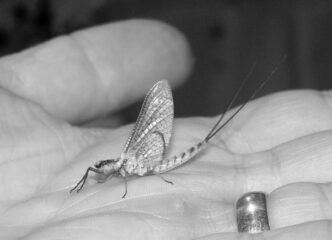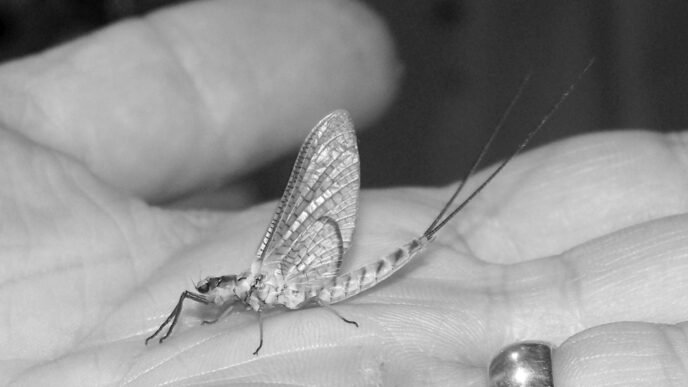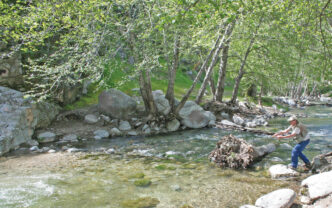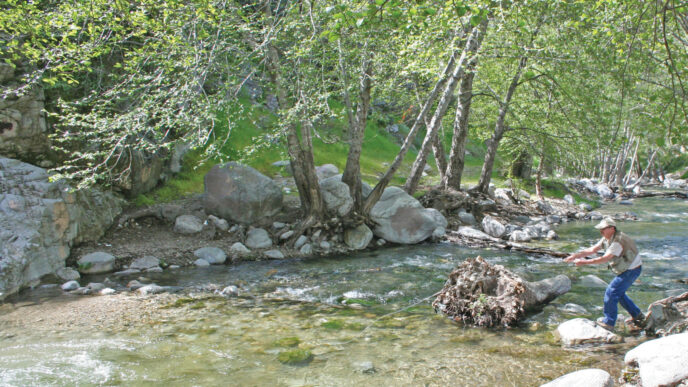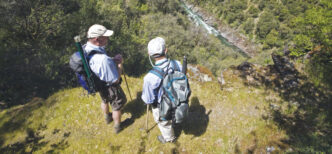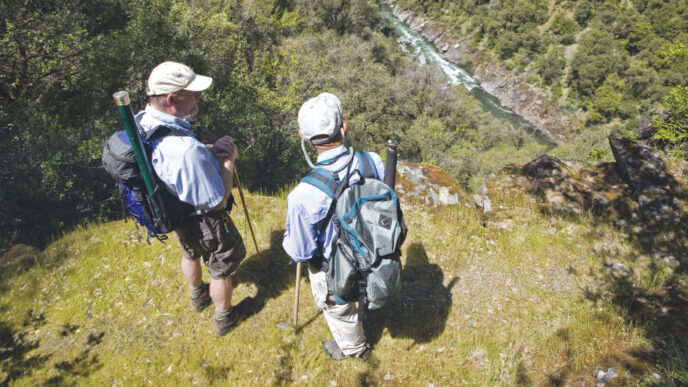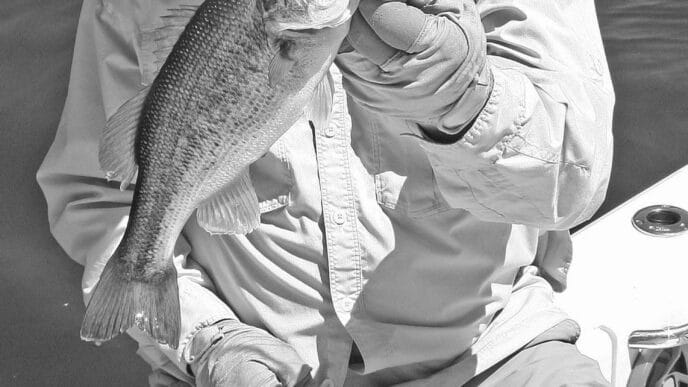When I conceived the idea of camp fare as a theme for the “Foraging Angler” column, I had in mind the title of Claudia Rodin’s classic cooking book Everything Tastes Better Outdoors. That and your publisher’s tag for the column, “There’s more to fishing than fishing,” became my underlying philosophy.
Fishing lunches almost always are outdoor affairs, beside the stream, and while everything really does taste better outdoors, a good streamside picnic can make a bad day of fishing good and a good day of fishing better. Whether lunch is a classic peanut butter and jelly sandwich, a designer deli concoction that you grabbed in town on the way to your favorite stream, or a sumptuous picnic basket complemented with a crisp chilled sauvignon blanc, the equation of fresh air, flowing water, and good company can provide quality moments. Throw in the excitement of a fishing adventure, and it just gets better. Good sport, good food, and good company are synergistic.
Angling writers know this, and angling literature is replete with memorable lunches. In The Sun Also Rises, Ernest Hemingway writes of a day’s fishing on a stream in Spain’s Pyrenees. Jake Barnes and his friend Bill leave a hotel in Burguet and cross the hills of the Valley of the Rio de la Fabrica with a rucksack filled with a roast chicken, hard-boiled eggs, and bottles of a “rusty” wine that would be tucked into a spring on the Irati River for their midday meal. From my travels in Spain, I suspect there was a loaf of freshly baked bread and maybe some sausage, too. They got trout, both on worms and on a McGinty. Papa Hemingway understood that many elements go into a good day in the field, and a satisfying streamside lunch definitely is one of them.
His son Jack, a skilled angler and conservationist, also liked to stop and smell the roses. My good friend and occasional fishing partner, the late André Puyans, told of fishing with Ernest Schwiebert and Jack Hemingway. Often there was a picnic basket and a bottle of Sancerre chilling in the watercress.
The late Ernest Schwiebert also loved the good life passionately and pursued it vigorously worldwide. Andy Puyans said that when fishing with Schwiebert, often there was a silver-jacketed flask filled with a smooth, single-malt scotch and a picnic basket stocked with cold roast chicken, fine cheeses, and a bottle of wine.
In Death of a Riverkeeper, Schwiebert tells of a day angling with Dermot Wilson, who was England’s authority on the dry fly and who held many good beats on the chalk streams. When they break for lunch, motivated by poor fishing, rain, and an absence of hatches, Dermot produces a picnic basket: “The split-willow hamper was filled with roast beef and stone-milled bread and lettuce, and I sliced a fat tomato and gathered some watercress from the carrier hatch. There was a bottle of Chateau Lynch-Bages, and several bottles of English ale, along with a thermos of hot Darjeeling and a small wedge of Stilton.”
I’ve had some memorable on-stream lunches that rival Schwiebert’s. In 1979, I was deep into the throes of my obsession with all things related to fly fishing. After a fly-tying class, Andy Puyans and I decided over a few shots of Balantine’s that I should make a pilgrimage to the chalkstream country of England’s Hampshire and chase my English/Irish/Scotch heritage. I would fish the River Test, drink in its rich angling history, much of which is the foundation of our sport, and visit Izaak Walton’s grave in the south transept of Winchester Cathedral.
Andy put me in touch with Dermot Wilson, Schwiebert’s host, and in overseas phone calls, Dermot arranged for my wife and me to stay in Nether Wallop’s Fifehead Manor. The stone foundations went back to the eleventh century. Lady Godiva’s famous ride in the buff went through the Wallops. Nether Wallop, Middle Wallop, and Over Wallop are among Britain’s most colorful villages. We would fish one of Wilson’s best beats on the fabled Test. Protocol was rigid at that time on one of the most revered rivers in the world. They did relax the coat-and-tie rule for me, but did not relax the requirement of casting only to sighted trout or omit the midday break for a good lunch. After a morning’s angling that took us downriver, we returned to a fishing hut for our respite. Our ghillie, Charles, produced a tablecloth, linen napkins, freshly steeped tea, and a split-willow hamper filled with biscuits, roast pheasant, Stilton, and fresh fruit. There was a Côte de Rhone and fine conversation. In that conversation, we chose to forsake numbers and go after a huge trout that afternoon. I got my fish, and we raised many glasses that night in the village pub.
The visit was an epiphany of sorts for me. I came to cherish my sport, and I started to look more at my surroundings and to value the friendships even more than the angling. This was also one of the first times I had fished with a guide, and through him I learned of rich history and traditions and of birds and plants that were new to me. The fee of a hundred dollars nearly choked me, but it turned out to have been one of the best investments I’ve made in my life.
Puyans loved good food, too. I have fond memories of gathering on the banks at Hat Creek before the evening rise. Our entourage would spread picnic tablecloths and gather in a circle to munch on hors d’oeuvres that would hold us until our late meal in camp. We would plan our attack on the trout, choose our stations, and once entering the water, would fish into darkness. In late May or early June, twilight comes late. Car and truck headlights guided us on the circuitous route back to our camp in Cassel. Dinner might not be over until midnight.
A streamside lunch is often a memorable part of a float trip. Some guides are known both for their angling prowess and for their cooking skills. Jack Dennis won Curt Gowdy’s admiration for his guiding, angling skills, and fly tying, but he was also a mean cook. Gowdy featured Jack on American Sportsman, the father of all television outdoor shows, after Jack guided him on the Snake River. Perhaps it was the good company and the streamside meals that were part of the equation that made Jack famous.
My wife, Karen, and I floated with Jack on the Snake one autumn in the mid-seventies. It was our first float trip. We slept in our van and, to save money, we washed up every three days at a coin-operated shower behind a gas station in Jackson Hole. Bob Rogers was an editor for Western Outdoors who operated out of a small office next to mine in Pleasanton, and it was Bob who put us in touch with Jack.
It was our first trip to Jackson Hole and Yellowstone. The Snake is a big river. There was morning mist with frost on the grass, and the fall aspens were a riot of amber and gold. Their backdrop was the grandeur of the Teton Range, first named by French trappers longing for the tender breasts of their women left at home. Jack taught us to look for and identify the seams of greenish water that held the cutthroats. The excitement of running the river, catching beautiful fish, seeing moose and elk at river’s side, and the overwhelming sensory input of a float trip on the Snake made the morning pass quickly.
We were getting hungry when Jack beached the raft. We gathered sticks, built a fire, and grilled our lunch in a foil packet. The crisp fall Wyoming air made us ravenous. I can’t remember many better meals. Over steaming coffee, Jack asked if I wanted to hike up a spring-creek slough and try for a big fish, and I jumped at the chance, leaving Karen with a rod and a book. Jack and I found our fish. We also got dunked when a log bridge broke under our weight. We laughed as we half ran back to camp, concerned over Karen’s being alone. She was reading her book, ignoring the throbbing fly rod that was tucked into the forked branch of a big piece of driftwood. She hadn’t been able to land the huge cutthroat that had taken her fly, so she had loosened the drag and had stuck her rod in the tree. Karen had read two chapters by the time of our return. I landed and released the fish. It was much bigger than the ones we crowed so much over on the spring creek.
Our shenanigans put us behind schedule, and Jack rowed hard to get us off the river before dark. On the road, we saw lights at the small rodeo corral in Wilson and pulled over. While we sat on the fence railing like the other Stetson-hatted cowboys, somebody tossed us beers. Later, we ordered thick steaks in Jackson Hole and downed a few at the Silver Dollar Saloon while a two-bit band played the best country-western music that we can remember.
Lunch on the snake river in Wyoming with Jack Dennis was memorable, but so were the streamside lunches on the Kolpakova River in Kamchatka. Our guide there was Volodya, a Russian Air Force fighter pilot who had lost his job when the USSR broke up. To earn a living, he had returned to his roots in wilderness Kamchatka and had learned about fly fishing so he could guide. He was Will Blair’s campmaster in a small tent enclave set up on a side channel of the Kolpakova on the western side of the mountainous volcanic spine that runs down the middle of this Siberian province. All supplies were brought in by Russian Mi-8 helicopters, as were three jet sleds. Volodya oversaw the construction of rod racks, shower towers, a drying room, and an outhouse. He built them from trees cut down with an axe and chain saw. The small enclave housed a Russian biologist, six American anglers, Russian camp workers, and two American, one Canadian, and one Russian guide. Volodya’s tent housed his wife and two small children.
The camp on the Kolpakova was an experiment. The river was thought to be the world’s best dry-fly trout stream. A Russian-American outfitting company was formed to open this fabulous place to sport fishing. Each day, three groups consisting of two anglers and a guide headed out after breakfast in a jet sled to prospect water never before fished. We went 40 miles upriver toward the mountains and 30 miles downriver toward a braided delta that flows into the Sea of Okhotsk. We rotated guides and headed out to explore the unknown: there were no people, and there was no logging, no mining, no agriculture, and no other habitation for 150 miles in all directions and only a handful of people on the entire western side of a peninsula that is nearly the size of California.
Since I had learned a little Russian for the trip, I was privileged to fish with Volodya several times. Though not as skilled in the nuances of fly fishing as the Western guides, he knew the river and its fish better than anyone. He was also a tough hombre, carrying a 12-gauge shotgun, an oversized sheath knife, and an axe at all times. At the campfire, we voted him the person most able if we were stranded overnight on the river.
Each day, we stopped for a streamside lunch, with time for conversation and a little nap. Volodya set a good wilderness table. There was always a fire made from gathered driftwood. The center of our meal was a freshly caught sea-run Dolly Varden that was salted and peppered and wrapped in foil. The ample oils and skin of this colorful char gave a rich flavor. Volodya spread an oiled tablecloth and carried a black cast-iron teapot that went on the fire as soon as the flames leaped up. He laid out sausage made from wild game, cucumbers, and a luxury item, tomatoes, along with Russian crackers. We drank tea, munched on the crudités, devoured the succulent fish, and practiced our respective new languages. Volodya was very proud of his table. I knew that hospitality was important to him, and also that many Russians never ate this well.
I was in the air force and had flown. It was during Vietnam and the Cold War. Volodya and I had been enemies back then, but not after those days on the river and those lunches on the sandbars of the Kolpakova. He also put me on the biggest rainbow of the trip. On that same day, we found nerka, the Russian word for fresh-run sockeyes. We were heroes in camp that evening. Provisions were running low, and fresh meat was in short supply.
I remember other great streamside lunches, as well. When a group of friends and I headed for Argentina a few years ago, I made the arrangements with an Argentine outfitter to eat the food that Argentineans eat and share their meal customs. Dinner is always very late in countries that have had Mediterranean and Spanish influences. It can be taken at ten or even eleven at night. Lunch is also taken late, and it is a celebration, as well as a well-deserved break for everyone, including the guides. Whether in the Patagonia hills or on the Iberian marshes, lunch usually includes asado (grilled meat). A fire is built, and steaks or chorizo are grilled on the coals. Homemade empanadas stuffed with pork or beef and vegetables are served, and it’s all washed down with a savory Malbec and followed with homemade pastries. After that great meal and a siesta, there were hours more on the river before dark, and we knew that everyone would again be hungry when we finally left the water.
Several of us who were on that trip now gather on Sundays during Indian summer afternoons on the banks of the lower Yuba to celebrate life the way we did in Argentina and a year later in Chile. We invite friends, wives, significant others, and young and old. Three generations are there. We haven’t roasted a whole animal on the “iron cross,” the way they do in Argentina, because open fires are prohibited, but a Webber can do a mean rack of lamb, and the pot-luck dishes rival those in South America. It’s great fun.
But any streamside lunch can be memorable. A new friend and I fished the Little Truckee last November. One of the early storms that characterized our prolonged wet and cold winter was approaching, but we thought we had a window, and it might be a last visit of the year. Water levels were low, but fishable, and we had the river to ourselves, a rare thing on this stream these days. No trout came to our flies, though, and we wandered upstream, looking for rises or signs of fish. The leading edge of the storm brought winds. It was freezing, but you knew that you were alive. We broke for a late lunch and used two streamside pines on the high bank near the big bend for a windbreak.
I had leftover barbecued chicken, my friend a sandwich. We washed our food down with bottled water and searched for an angling answer. As we hunched behind the two pines, a marsh hawk that I’ve known a long time soared above us, and a coyote slinked across the meadow. Geese lay beyond us in the bunchgrass. The wind dropped a bit, several trout showed their noses, and we went home without a skunk. God that was good chicken. Everything tastes better outdoors.






